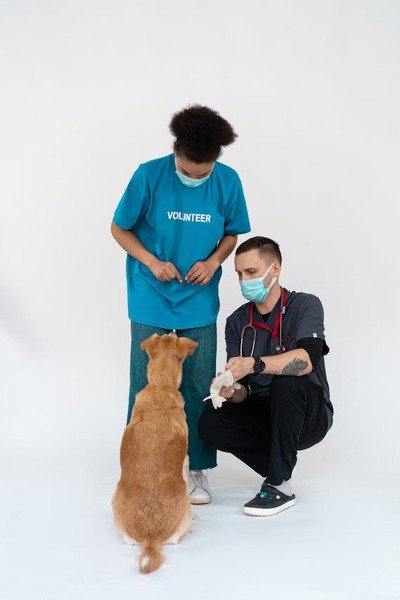Are you constantly sneezing or getting itchy eyes every time you snuggle with your furry friend? If you’ve nodded in agreement, you might be among the many people who have pet allergies. It’s a bummer when you love animals, but your body seems to be on another page. So, let’s sit down together and unpack how these allergies come to be and the tell-tale signs that you’re reacting to your pet. Don’t worry; we’ll keep things simple and to the point, just like chatting with a friend who has all the deets on allergies.
How Pet Allergies Develop
So, how exactly does someone develop an allergy to pets? Well, our immune systems are designed to fight off harmful invaders like viruses and bacteria. But sometimes, our defenses get a bit too enthusiastic and misidentify harmless things, such as pet dander (tiny flakes of skin), saliva, and urine, as threats. So when your body goes into defense mode, it produces antibodies and releases histamine, which leads to those annoying allergic symptoms. That’s right; it’s not the fur itself but the proteins in the dander, the saliva, and the pee that make you all sneezy and stuffy.
Common Symptoms of Pet Allergies
If you have a pet allergy, your body may express its dismay through various symptoms. Here are a few to watch out for:
-
Getting a bout of sneezes every time you’re around pets
-
Watery or itchy eyes that seem like an overreaction to a sad movie
-
A runny or stuffed-up nose that isn’t related to the common cold
-
The dreaded itchy skin or hives where your pet brushed against you
-
Coughing or wheezing, which is your lungs joining the complaint choir
Now, these are just the standard responses. Some folks might also get an itchy throat or even experience asthma symptoms if they have an existing condition. It’s our body’s way of saying, “Hey, this pet thing isn’t working out for me.”
Factors That Influence Pet Allergy Development
Ever wonder why some of us get pet allergies while others remain unfazed? There are a couple of factors in play:
-
Genetics: Yep, if your family members have allergies, you’ve got a higher chance of joining the club.
-
Exposure: The more you’re around animals at a young age, the lower your chances of developing allergies later on.
-
Types of Pets: Animals that produce more dander, like cats and some dog breeds, are often more likely to trigger allergies.
Diagnosing Pet Allergies
Do you think you might be allergic to your pet? The first step towards confirmation is often a visit to the doctor for allergy testing. You could get skin prick tests or blood tests to determine whether you’ve developed a significant reaction to pet allergens.
Moreover, a doctor can help you pinpoint the exact cause of your symptoms, which is super useful when you have a pet at home. Sometimes, it turns out that it’s not the pet’s fault at all; maybe it’s dust or pollen that’s causing the upheaval.
Getting more info about routine exams is explained through a doctor’s visit, where they can go over the various checks and tests specific to allergies, ensuring you’re well-informed about your condition.
How to Manage Pet Allergies at Home
Living with pets when you’re allergic can be challenging, but it’s not always mission impossible. Check out a few strategies to reduce allergy symptoms:
-
Keep it clean: Regular cleaning can reduce allergens in your home. This includes vacuuming, dusting, and washing your bedding frequently.
-
Create an allergen-free zone: Designate a pet-free space in your home, like your bedroom, to give yourself a breather.
-
Invest in an air purifier: They can capture some of the allergens floating around your living space.
-
Bathe and groom your pet regularly: This can reduce the amount of dander they spread around. Plus, they’ll look extra cute and clean.
Remember, if you’re curious about cat and dog shots and wondering if they might help with allergies, that’s actually not the case. These shots are vital for your pet’s health, safeguarding them from various diseases, but they won’t alleviate your allergic reactions.
Medical Interventions for Pet Allergies
When home remedies aren’t enough, the next step might be medical interventions. This could range from over-the-counter antihistamines to nasal sprays and even allergy shots (for humans, not pets). It’s about finding what gives you the best relief with the least side effects.
If you’re looking at a long-term solution, dog and cat allergy treatment can be done in several ways, including immunotherapy. These allergy shots or drops gradually get your body used to the allergens, potentially lessening your sensitivity over time.
Living with Pets Despite Allergies
Love triumphs over allergies when it comes to our pets, right? Well, in most cases, that’s true. Many people find ways to manage their symptoms while keeping their furry friends around. It’s about adjusting, compromising, and sometimes getting creative with solutions.
So, whether it’s setting up a pet-free zone or sticking to a strict cleaning schedule, where there’s a will, there’s a way. The bond between you and your pet can often be the motivation you need to tackle those allergies head-on.
When to Seek Professional Advice
If you’re struggling to control your allergy symptoms or they’re impacting your quality of life too much, it might be time to talk to an allergist. They can offer advice tailored specifically to your situation, which is what you need to find a comfortable balance between your health and pet ownership.
Final Thoughts
In summary, dealing with pet allergies is manageable with the right strategies. Living with pets while being allergic can be challenging but isn’t impossible. Effective management and treatment allow you to enjoy your pets with minimal discomfort. Keep your space clean, stay informed, and seek professional advice if needed. Many others are in the same situation, successfully balancing their allergies and pet companionship. It’s all about making adjustments and finding harmony with your pets. Embrace the journey for a happier, sniffle-free life with your furry friends.





